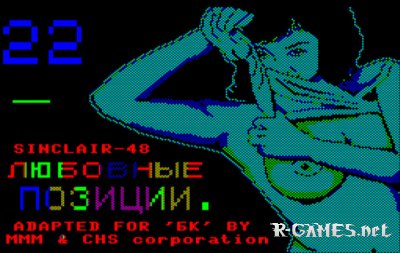Igri Dlya Bk 0010
Vilnius BASIC on a BK-0010.01 The BK series was essentially a barebones machine, without any peripherals or development tools. The only available at the launch (except ) was an included magnetic tape with several programming examples (both for BASIC and ), and several tests. The ROM firmware includes a simple program to enter machine codes, BASIC and FOCAL interpreters. While the BK was somewhat compatible with larger and more expensive professional model and industrial like the series, its 32 KiB memory - of which only 16 KiB was generally available to programmers - (an extended memory mode supported 28 KiB, but limited video output to a quarter of the screen) generally precluded direct use of software for the more powerful machines. The DVK became a popular development platform for BK software, and when the BK memory was later extended to 128 KiB, most DVK software could be used directly with minimal changes.
KLAD game for BK-0010 soviet computer. Music composed by me in early 2000s for a few arcade games on. Drop a.COD.BIN.BKD.IMG.ROM file here, or zipped one. BK0010 + Basic ROM, Reset restart (F12), Reload clear all, BK0010 + Focal ROM, BK0010+FDD.
Developers quickly filled this niche, porting several development tools from DVK. This led to an explosion of homebrew software, from and to. Most BK owners expanded the built-in RAM to at least 64 KiB, which not only allowed easier software porting from more 'grownup' systems, but as these upgrades often included controllers, creating a one's own became something of a competitive sport in the BK scene. Games and communities also flourished, as its anemic graphics were offset by a powerful CPU. One of the was, although officially the computer was shipped with, a modification of. Hardware [ ] The machine is based on a powerful (for the time) 16-bit single-chip CPU, clocked generally at 3 MHz. It is almost perfectly compatible with 's LSI-11 line, though it lacks and further instruction set extensions.
The manufacturer also closely copied the PDP-11's internal architecture. Each model has one free card slot which is electrically, but not mechanically, compatible with. Pravila oformleniya etiketok v muzee.
The first versions has 32 KiB onboard, half of which was used as. That is extended to 128 KiB in later models, with video memory extended to two 16 KiB pages. Video output on all models is provided by the, a rather spartan chip.

It is actually a standard 600-gate with a VDC program that allows for two graphic video modes, high-res (512×256, monochrome) and low-res (256×256, 4 colors), and supported hardware vertical. Later models has 16 hardwired 4-color sets selectable from 64 color. It does not support text modes, but simulates two via routines: 32×25 and 64×25.
Some operating systems such as ANDOS have managed to output text in 80×25 mode when displaying documents imported from IBM PC, by placing characters more densely. Output is through two separate 5-pin for a monochrome TV or color TV/monitor. Sound on all models is initially through a simple programmable counter connected to an onboard. Later, the became a popular aftermarket addition.
All models also has a 16-bit universal with separate input and output buses for connecting peripherals such as ( printers used the incompatible interface instead of the more popular port, so Centronics printers needed an adapter), or for sound output, and port for data storage. Later models includes a manufacturer-supplied controller (that can be plugged into a Q-Bus slot) by default. It was available for earlier models as an aftermarket part, but homebrew ones (that also often extends rather anemic 16K memory of original BK) are more popular. Tigri poyavlyayutsya nochjyu onlajn.
A cottage industry for such peripherals and mods flourished. Versions [ ]. BK 0011M Some changes in the BK-0011, while minor, made it incompatible with earlier -0010 models.